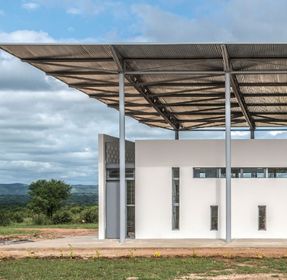Chipakata Children’s Academy
CHIPAKATA CHILDREN’S ACADEMY
Susan Rodriguez + Frank Lupo + Randy Antonia Lott
ARCHITECTS
Susan Rodriguez + Frank Lupo + Randy Antonia Lott
LOCATION
Lusaka, Zambia
AREA
20000 ft²
PHOTOGRAPHS
Rob Duker, Fabian Bedolla, Gord Ray and Joseph Mizzi
PROJECT YEAR
2015
CLIENT
14+ Foundation, Inc., New York, NY
ARCHITECT DESIGN TEAM
Fabian Bedolla (on-site project architect), Hiroko Nakatani (Ennead Lab).
STRUCTURAL ENGINEERING
Silman, Nat Oppenheimer
SITE AREA
Approx. 100 acres
DESIGN PRINCIPALS
Randy Antonia Lott, Ennead Architects, Susan Rodriguez, Frank Lupo
CONSTRUCTION MANAGER
14+ Foundation, Inc. Joseph Mizzi (Sciame Construction), Fabian Bedolla (on-site Construction Manager)
Text description provided by architect.
The Chipakata Children’s Academy is a new primary school in Zambia, Africa. It is the first initiative of the 14+ Foundation, a New York City-based non-profit organization established in 2012.
The design for the new school has realized the Foundation’s mission to develop, build and operate schools and orphanages in rural African communities.
The site in Chipakata Village is approximately 100 kilometers east of Lusaka, Zambia’s largest city.
Situated on level topography with views to the surrounding hills east and west, the project defines a sense of place and community for the Village.
Locating the school within the Village has dramatically reduced the distance the children must walk to school each day, as the nearest school is seven kilometers away.
The Academy provides a comprehensive primary school education, grades 1-7, for children in seven villages in and around the Chipakata Village community.
The first phase of the project, which opened in January 2015, includes a classroom building, community pavilion, administrative office and teachers’ housing.
Nearby, agricultural fields dedicated to generating food and income support the operation of the school and ensure long-term economic sustainability for the project.
Local village residents were key participants throughout the development and construction process.
Referencing regional school planning typologies, the design of the classroom structure transforms the standard model to create a new paradigm.
The design provides for ten teaching and learning spaces compared to the four rooms found in the typical prototype.
This is achieved by breaking down the monolithic volume of the typical classroom bar building and introducing open space for collaborative activity between classrooms.
Additionally, elevating the roof canopy above the masonry base allows for an upper level accessible by stair, with open-air spaces directly above each of the four classrooms.
Informed by the local climate and solar conditions, the window openings and roof canopy are configured to maximize daylight within the classrooms.
Clerestory windows are integrated into all the classrooms with a continuous roof overhang serving to protect spaces on both levels from harsh solar gain during the summer months.
Adjacent to the classroom building is a community gathering space — a triangular shaped structure — providing shelter from the sun and rain and a flexible space for eating, gathering and community celebrations.
The construction of the buildings is based on a modular approach to both the masonry units of the classrooms and the repetitive structure of the roof canopy.
All materials were locally procured and assembled on-site. The textural quality of the unitized masonry construction is expressed in the screen walls that enclose the stairs at both ends of the building.


























